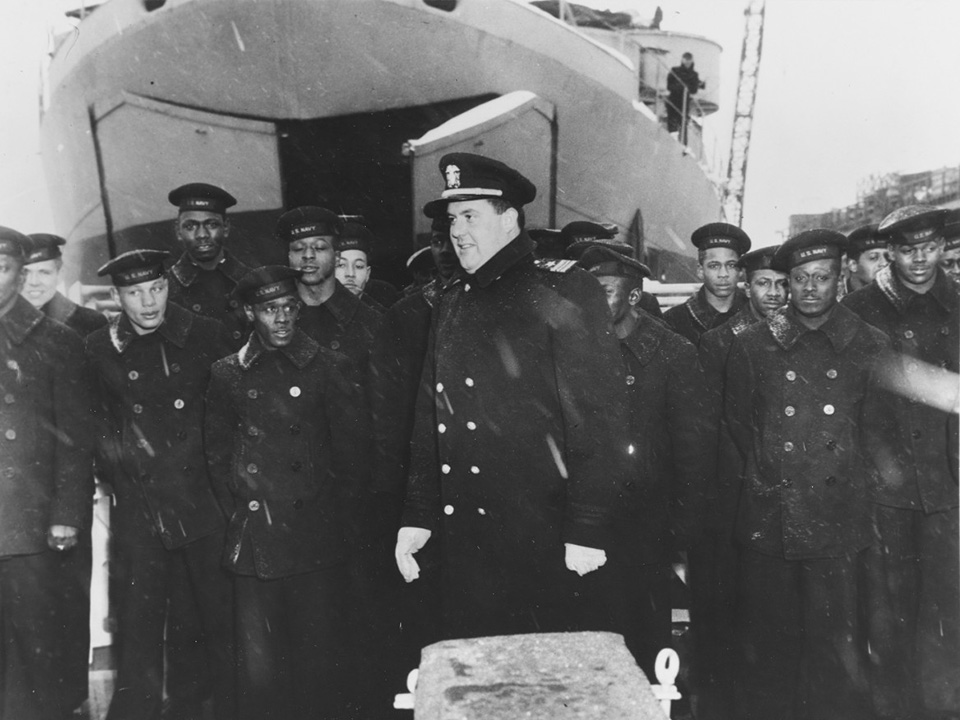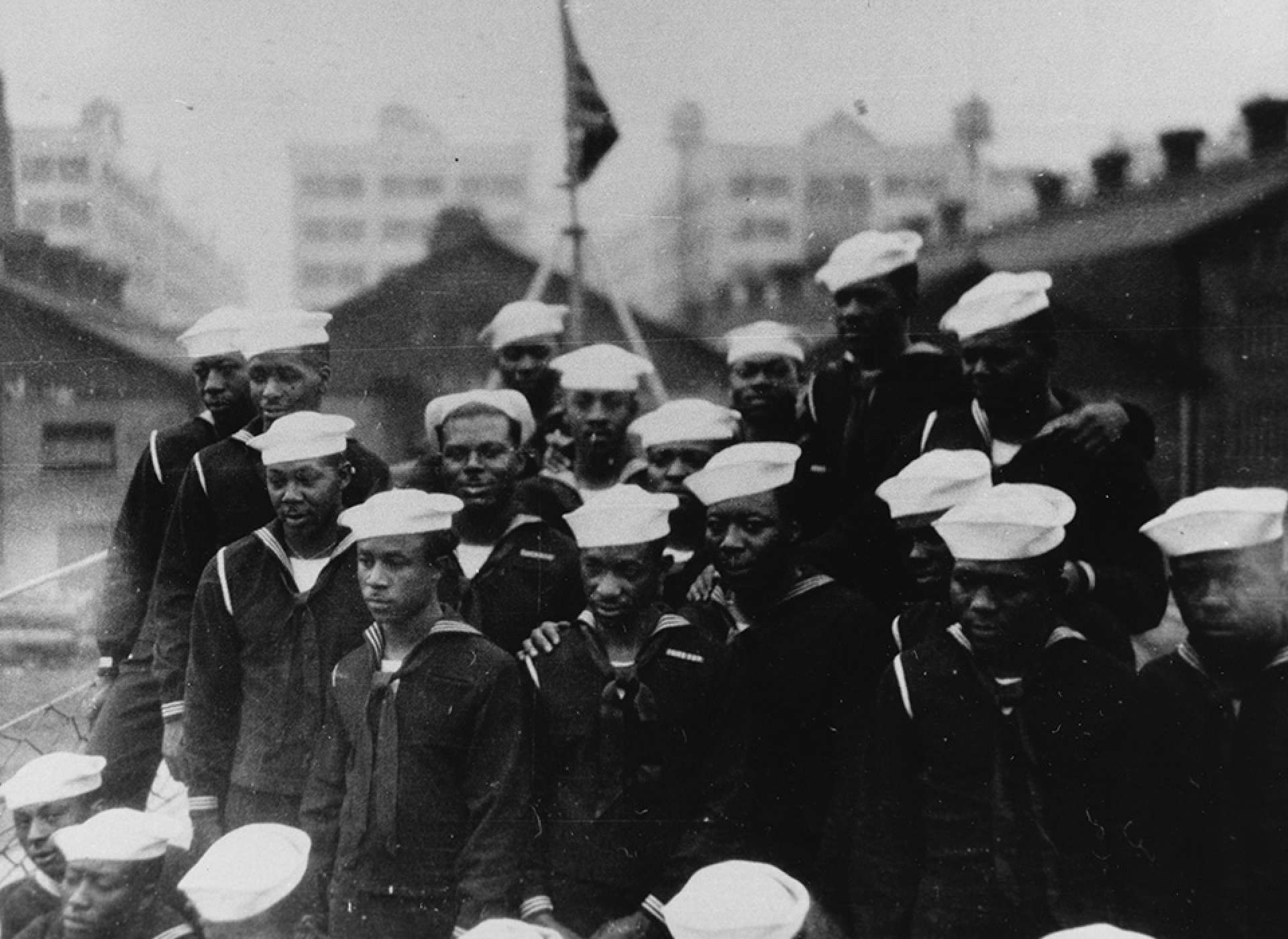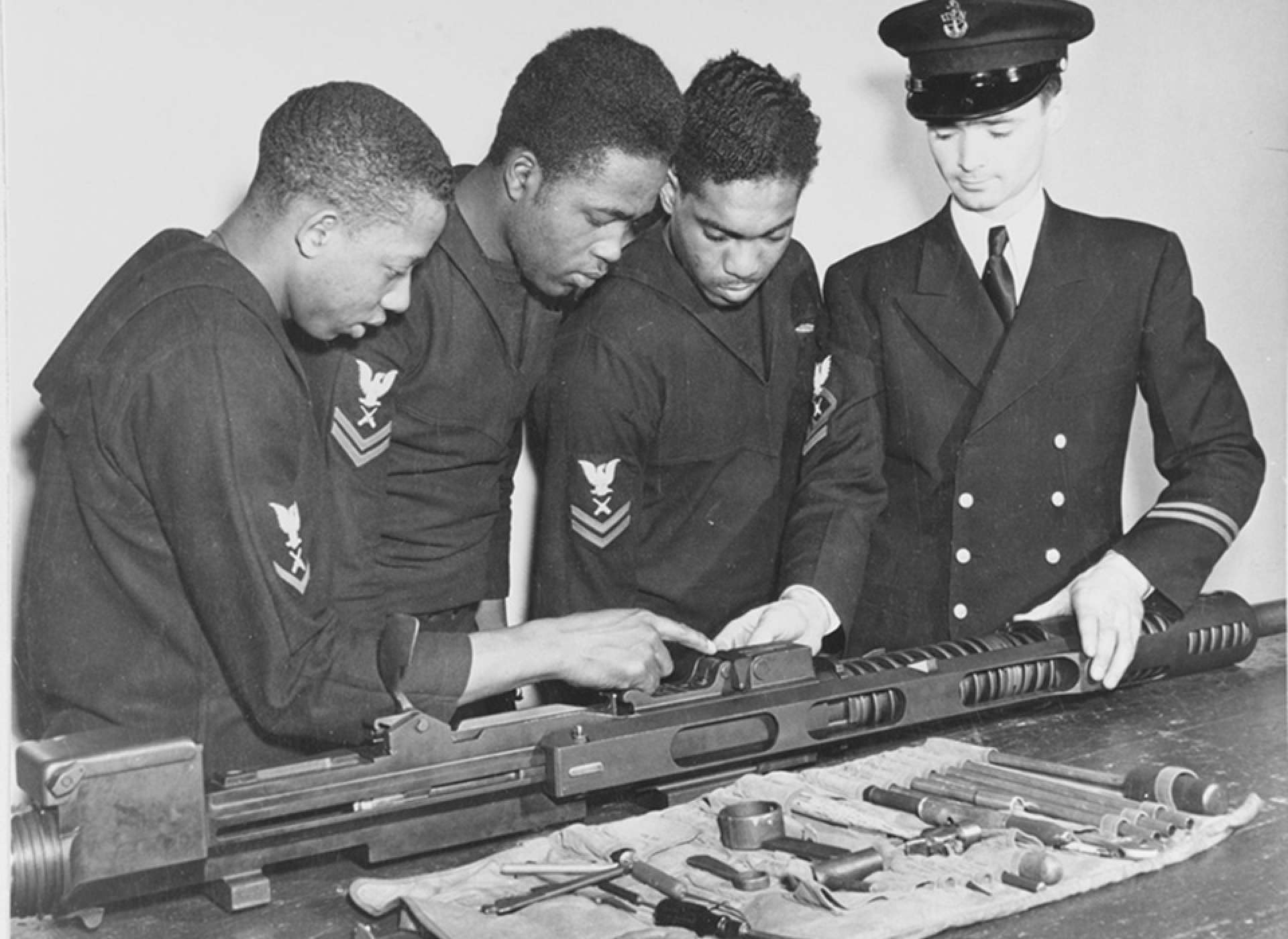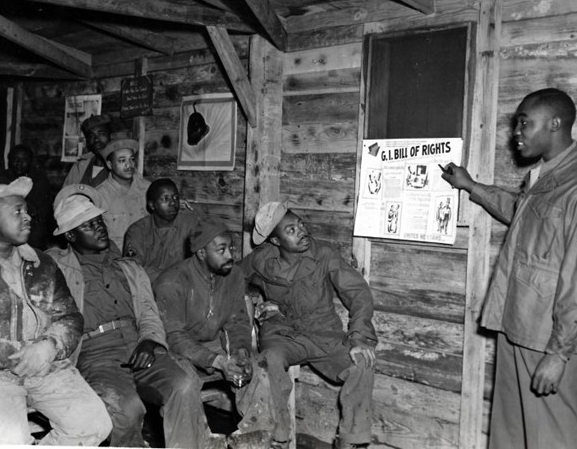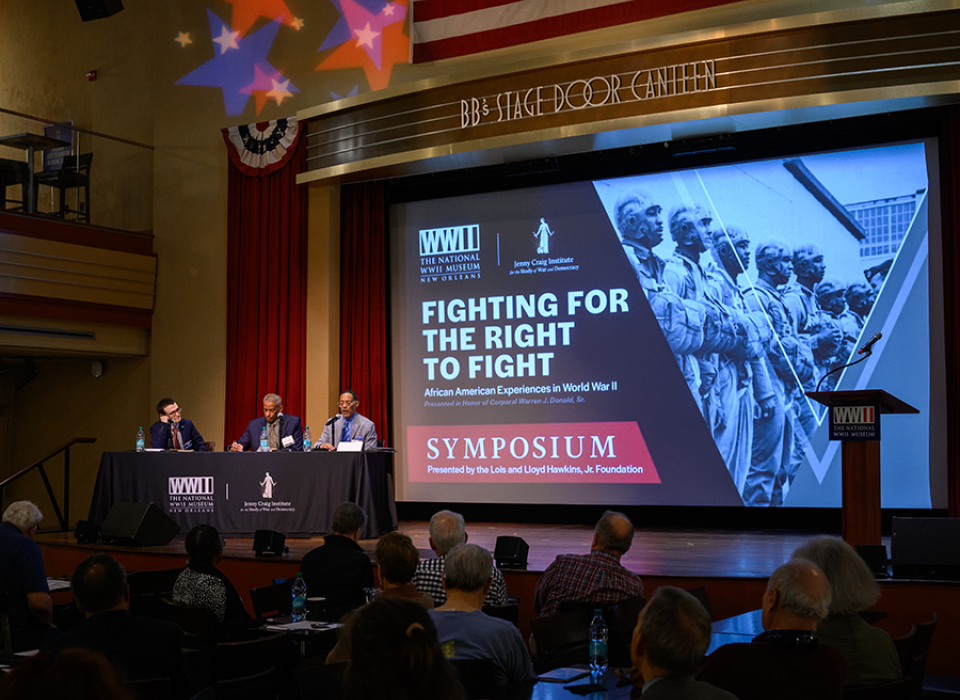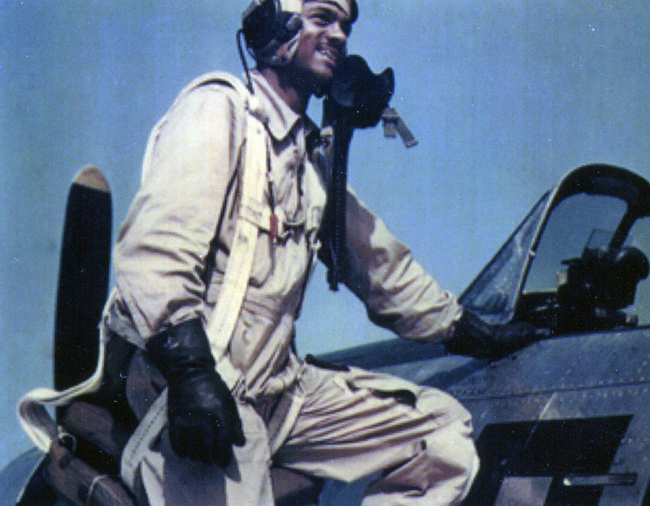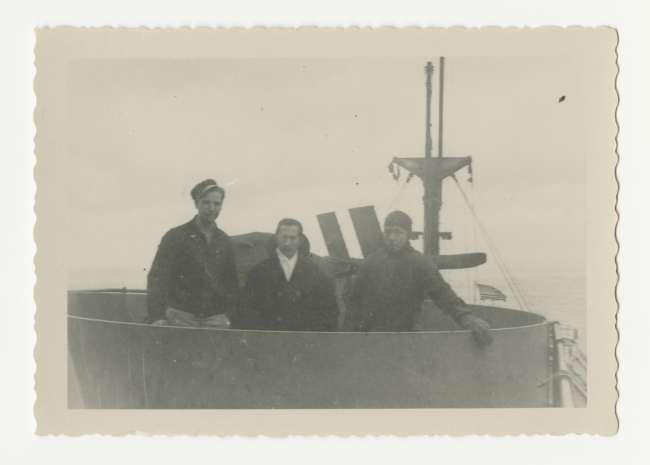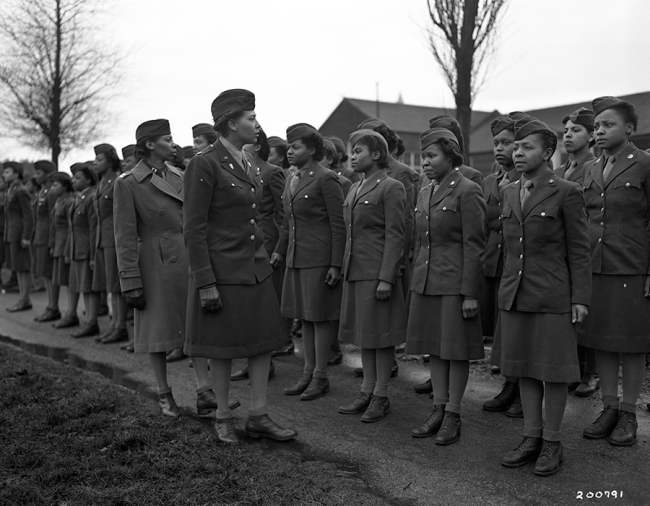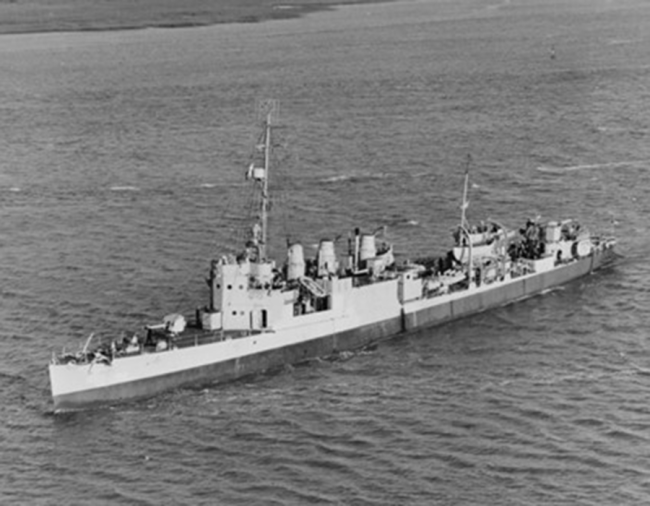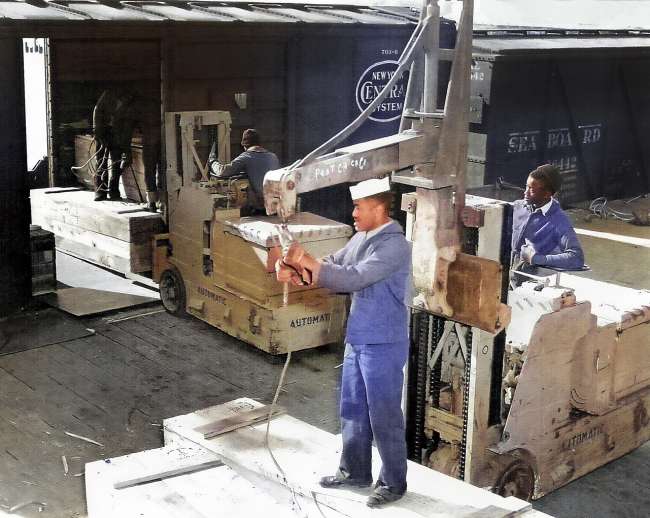The citation for Newton H. Mason’s Distinguished Flying Cross briefly extols his actions as a US Navy fighter pilot during the Battle of Coral Sea on May 7-8, 1942. It states “Ensign Mason zealously engaged Japanese aircraft, thereby contributing materially to the defense of our forces.” Exciting times for a young US Navy pilot fighting in a major battle, however, the emotions of this citation are dominated by one word—posthumous. On that fateful day, Ensign Mason took off from the USS Lexington (CV-2) and rose to meet attacking Japanese fighters on his first, and last, combat mission. It was never determined what exactly happened to him except that witnesses saw him drive into a pack of A6M Zero fighters. After that day Mason’s name was erased from the flying list, but soon it would live on in a different form.
Lieutenant Commander William M. Blackford, commanding officer of USS Mason standing among his crew on commissioning day. Although most of the crew were African Americans, there were only white officers and chief petty officers. Even with a “integrated” crew, the white sailors still lived in separate quarters aboard ship. Courtesy of the National Archives.
On March 20, 1944, just under two years after Newton Mason was killed, a new ship named in his honor was commissioned into the US Navy. The USS Mason (DE-529) was the second to last ship in the Evarts-class of destroyer escorts (DE). Destroyer escorts were a new class of vessels built for the US Navy during World War II. Designed to escort convoys and attack submarines, they transformed the Battle of the Atlantic. Smaller than a traditional destroyer, but larger than corvettes or patrol craft, DEs had all of the speed, armament, sea keeping ability, and range necessary to subdue or kill submarines. For all of their capabilities against undersea threats, they were somewhat of a compromise above decks. The armament was not as strong as a full destroyer and they lacked torpedoes to take on large surface ships. But they were cheap, easy to build, and filled an important role in the Atlantic and Pacific theaters. During the course of the war over 200 destroyer escorts were built and served as part of the fleet. They contributed in a role that was not the most glamorous, but one of the most important. On March 20, 1944, as the commissioning pennant broke on the mast of Mason and Lieutenant Commander William M. Blackford ordered his ship on her first patrol, something more than a US Navy ship was started that day. It was an experiment, but this experiment did not involve any special modifications to the actual ship.
The USS Mason had the same equipment, engines, and weapons as any of the other Evarts-class DEs. The experiment lay in the makeup of her crew. For the first time a US Navy fleet vessel was to be crewed predominately by African American sailors.
Since the American Revolution, African Americans have served on US Navy ships but not always in the best roles. These men worked in a broad range of positions, as crew, craftsmen, or servants. Although they were often not welcome, or their presence widespread, there were some very limited opportunities for them. The most bitter and discriminatory period, by comparison, of the modern US Navy began after World War I. With the downsizing of the US Navy, African American enlistment and recruiting were completely stopped. Beginning in 1919, African Americans were barred from all enlisted rates except for the Steward Branch where they could serve as cooks and attendants to officers. It was not until 1932 that enlistment of African American men into the US Navy was started again. However, for the next 10 years, any African American man that walked into a US Navy recruiting station was destined to become a servant to white officers.
Life in the Navy could especially be a bitter pill to swallow. Most men faced a harsher and more regimented form of segregation in the Navy than they had experienced in civilian life. They slept in separate quarters, were treated differently, given limited opportunity for advancement, and had to cook for and clean up after white officers.
As American involvement in the war began to look inevitable, rights groups saw the opportunity for the inclusion of African Americans as equals in military service. The biggest aid to these efforts was the language of the 1940 Selective Service and Training act which stated “any person, regardless of race or color, between the ages of eighteen and forty-five, shall be afforded an opportunity to volunteer for induction into the land and naval forces of the United States for the training and service...” These words began to wear down the edifice of the Navy’s racial policies. Beginning on June 1, 1942, African Americans were accepted into regular sailor rates, not just the Steward Branch. Men, such as Seaman Second Class Joseph LaNier, started to form construction battalions, work in shore stations, and even operate small district naval craft. But for all the progress that was being made, there were some things that the Navy would not budge on.
African Americans would not serve in combat units, they would not serve overseas, and they would not be allowed into fleet capital ships unless they were Steward ratings. The Navy was firm, and mostly successful, in its efforts to keep African Americans in menial roles, but it did not stop them from serving overseas. By June 1945, 165,500 African Americans were serving in the US Navy, 75,000 were in the Steward Branch, and over 120,000 of these men were overseas.
-

Enlisted crewmembers of the USS Mason standing on the bow in their dress blue uniforms in New York City, NY. Out of a crew of 204, 160 of the sailors on Mason were African Americans. Courtesy of the National Archives.
-

Prior to any ship commissioning the crew is given extensive training on all systems and weapons. Here Chief Gunner’s Mate Rex Ashley instructs future Mason crewmembers GM3c Albert A. Davis, GM2c Frank Wood, and GM2c Warren Vincent on the 20mm Oerlikon machinegun. Courtesy of the National Archives.
Only two combat vessels in the US Navy were crewed predominately by African American sailors, PC-1264 and USS Mason. Though both fighting ships, only the Mason had the distinction of being an overseas combat ship and thus gained special attention for being part of the “fleet” the Navy was so eager to keep African Americans out of. Crewed by 204 men, 160 of them African Americans, the Mason first pointed her bow east in escort of a convoy on June 14, 1944, when Convoy CK-3 departed Charleston, South Carolina, for England. Over the next 11 months Mason escorted five convoys to England or the Mediterranean. At the end of the war almost every ship produced a “war history” that summarized their overall action. The history for the Mason is only one page long. It is true that if you look on the surface it seems like the ship did not see much action during the war, but it is much more complicated than that. By the time USS Mason was commissioned, the worst of the U-boat attacks on convoys had passed. There was a noticeable drop in U-boat success after July 1943. From then on, U-boats were fighting a losing battle. Escorting ships rarely saw or engaged a U-boat, however, it was their constant vigilance that kept the underwater menace at bay. For that reason, no action is good news because submarines could not get to the convoy.
The defining event for the USS Mason happened during the arduous journey of Convoy NY-119. Departing September 19, 1944, this was a special convoy of tugboats, barges, and other slow-moving craft. NY-119 had the distinction of taking four weeks to cross the Atlantic, moving at a speed that averaged below five knots. Not only did the crew of the Mason have to defend against U-boat attacks, but it had to shepherd slow vessels, protect stragglers, and fight mountainous seas. This convoy was grueling to say the least, but the crew of the Mason never broke. They survived heavy storms, a roll of 70 degrees that should have capsized the ship, and were able to repair severe damage while underway. After escorting some of the faster ships to the convoy destination, the Mason turned back into the stormy weather to shepherd the rest in. For these actions, the commanding officer and the convoy commander put the Mason up for a commendation. Sadly, through either malice or bureaucracy, this commendation was lost and would not be approved for decades.
At the end of the war USS Mason had the same fate as many of her sister ships—decommissioned in October 1945, and sold for scrap in 1947. The experiment was short-lived but the men of the Mason proved they had what it took to operate a complex warship. They did not just defend convoys and survive stormy seas, each man fought through a system that was stacked against him and succeeded. These men were breaking barriers in the face of great adversity and doing their part to prove that they had the right, and the ability, to fight.
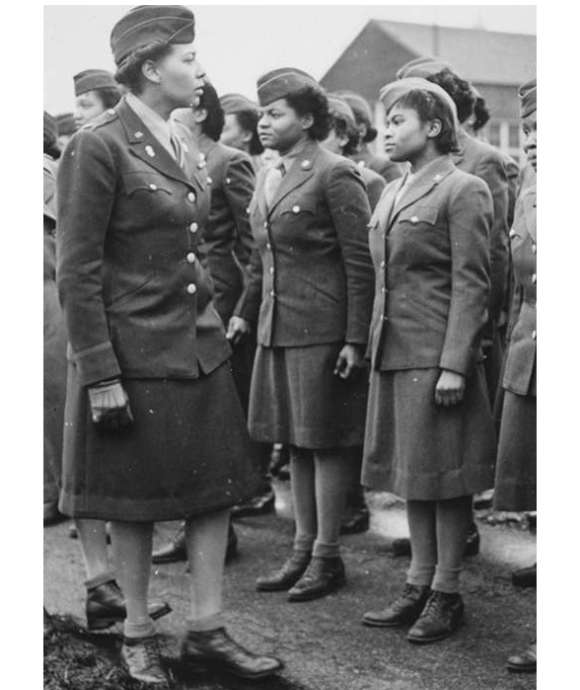
The SixTripleEight: No Mail, Low Morale
On February 3, 1945, the US Army sent over 800 black women overseas to England aboard the SS Ile de France. Their mission unknown to them.
Joshua Schick
Cite this article:
MLA Citation:
APA Citation:
Chicago Style Citation:

